Abundant forests, lush vegetation, deserts, and flowing rivers converge in the state of Oregon. This North American state is home to a rich variety of landscapes. Garter snakes have no problem finding a suitable habitat here and can be widespread throughout Oregon. Some of the habitats they call home include grasslands, shrublands, forests, streams, hillsides, and gardens. Let’s take a detailed look at garter snakes in Oregon. We’ll discover which species snake their way through this section of the Pacific Northwest.
Get Familiar with the Garter Snake
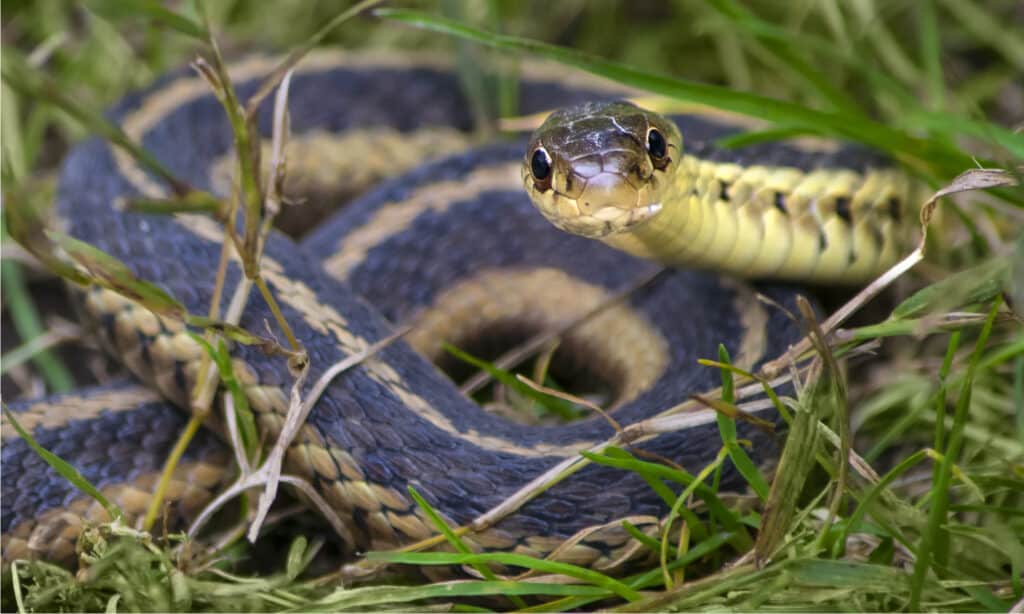
Four garter snake species call Oregon home.
©K Quinn Ferris/Shutterstock.com
Garter snakes are a common, nonvenomous garden companion. They help keep the pests at bay and prefer to stay mostly out of sight. The garter snake sometimes called a grass snake, is part of the Natricinae subfamily. Like most in this group, it is ovoviviparous and gives birth to live young. Its genus Thamnophis includes about 35 garter snake species. The name is derived from the Greek words thamnos, meaning ‘bush or shrub’, and ophio, which means ‘snake.’
Native to North America, the common garter snake species name is Thamnophis sirtalis. Sirtalis is Latin for “like a garter.” It likely refers to their similarity in appearance to old-fashioned sock garters. The common garter snake is further divided into 13 recognized subspecies, such as the red-spotted garter snake. You can find the common garter snake living in Oregon, but it’s only one of the species that call this state home. What other garter snakes live in Oregon?
Garter Snakes in Oregon
There are 4 species of garter snakes that live in Oregon. Don’t be surprised if you come across a common garter snake in this state; it’s one of the most prevalent snakes in the region. They’re diurnal snakes, so you might find them basking in the afternoon sun. Although a striking yellow dorsal stripe is a common distinguishing feature of garter snakes, it’s not present in all species. In fact, coloring and patterning can vary between species and even within the same subspecies. In addition to the common garter snake, the aquatic garter snake, western terrestrial garter snake, and the northwestern garter snake can be found living in Oregon.
Common Garter Snake (Thamnophis sirtalis):
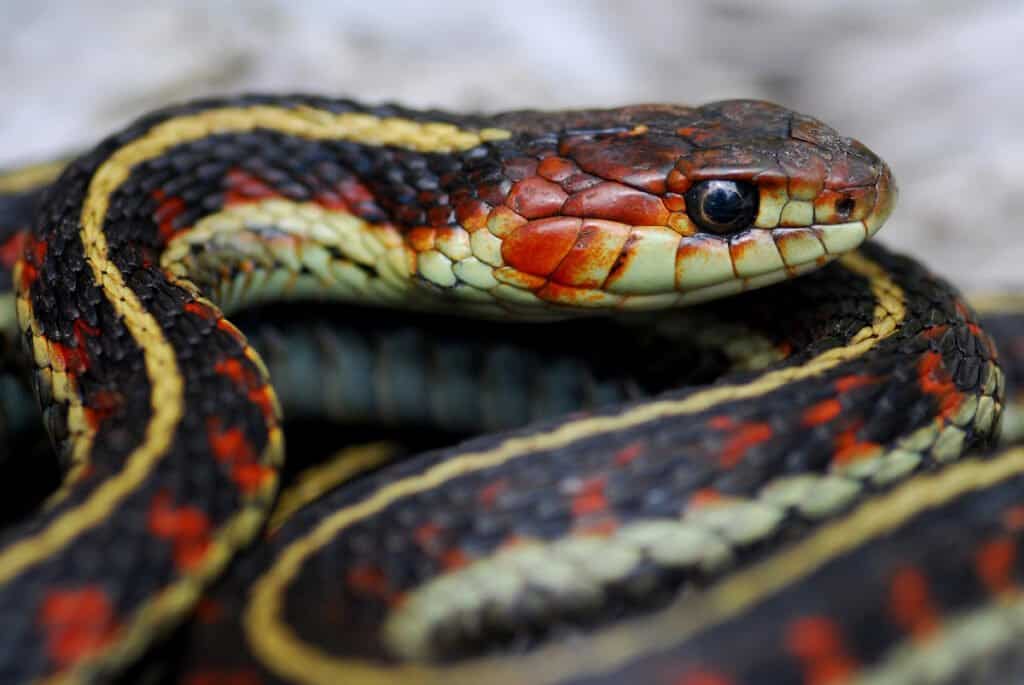
The common garter snake can absorb the neurotoxin from newts to deter predators.
©Jason Mintzer/Shutterstock.com
The common garter snake is the species you’re most likely to come across in Oregon. This is because it’s the most widespread throughout the state. It lives in forests from the mountains to the coasts, in the desert brush, and in backyard gardens. Appearance can vary with this species, and they’ll present a wide range of body coloring. Typically, these snakes have a yellow dorsal stripe that runs along the length of their bodies. As the largest of the Oregon garter snake species, this species grows 18 to 26 inches long, on average.
In eastern Oregon, where the climate is drier, you’ll find that common garter snakes always live close to water. These snakes don’t have venom that’s toxic to humans, but their bite transfers saliva that may be toxic to their prey. Interestingly, they are resistant to the poisons of the American toad and the rough-skinned newt. According to a study in the Journal of Chemical Ecology, they can actually absorb the neurotoxin from the newt into their bodies. They store the neurotoxin in their livers, rendering them poisonous. A fascinating way to deter potential predators!
Subspecies in Oregon:
- Red-spotted garter snake (T. s. concinnus): found only in the Willamette Valley of Oregon. This snake has a unique orange or copper-colored head. Its body is black with red-orange spots along its sides and a yellow dorsal stripe.
- Valley Garter Snakes (T. s. fitchi): lives throughout the state, except for the north coast and the most arid central regions of Oregon. They’re brown or black with red bars dotted between their 3 yellow stripes. They usually have the dorsal stripe down their back and one down each side of their bodies.
Pacific Coast Aquatic Garter Snake (Thamnophis atratus)
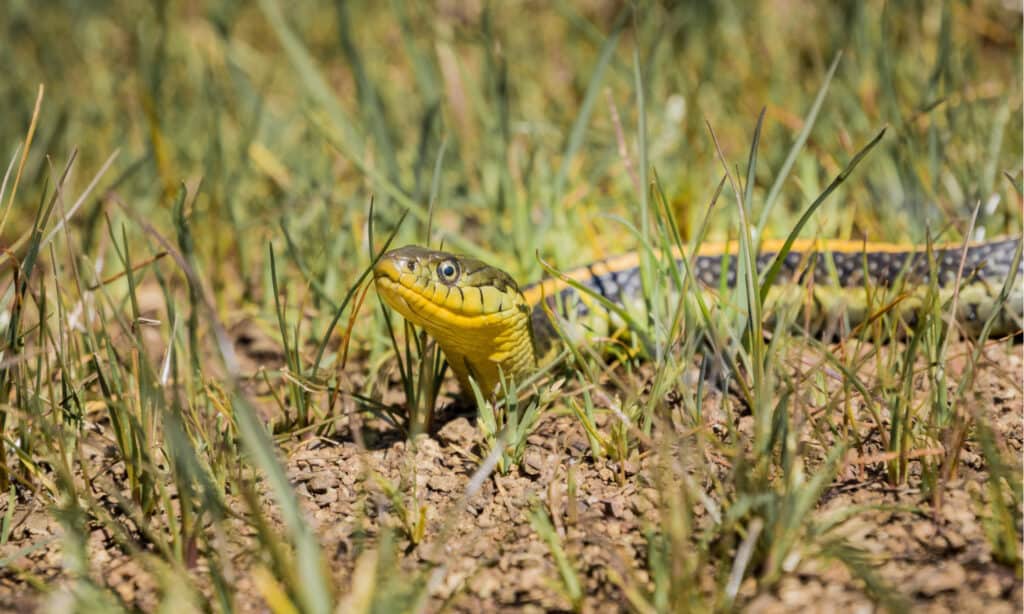
The Pacific Coast aquatic garter snake lives along water bodies in coastal Oregon.
©Sundry Photography/Shutterstock.com
As its name suggests, this is a highly aquatic snake species. You can find the aquatic garter snake living along rivers and other water bodies of coastal Oregon. Pacific Coast aquatic garter snakes live in wet meadows, marshes, wet forests, near streams, lakes, and ponds. They eat a diet of mostly aquatic insects, fish, and amphibians. Experts at escape, aquatic garter snakes can dive below the water and hide under cover of river rocks. Coloration varies, but they’re usually gray, brown, or black with various patterning. The yellow dorsal stripe typical of garter snakes may or may not be present in this species.
Subspecies in Oregon:
- Oregon Gartersnake (T. a. hydrophilus): ranges from the southwest portion of the state, along the coast to Douglas County. Their bodies are gray, olive-gray, or brown. They sometimes have the dorsal stripe and maybe stripes along the sides.
Western Terrestrial Garter Snake (Thamnophis elegans)
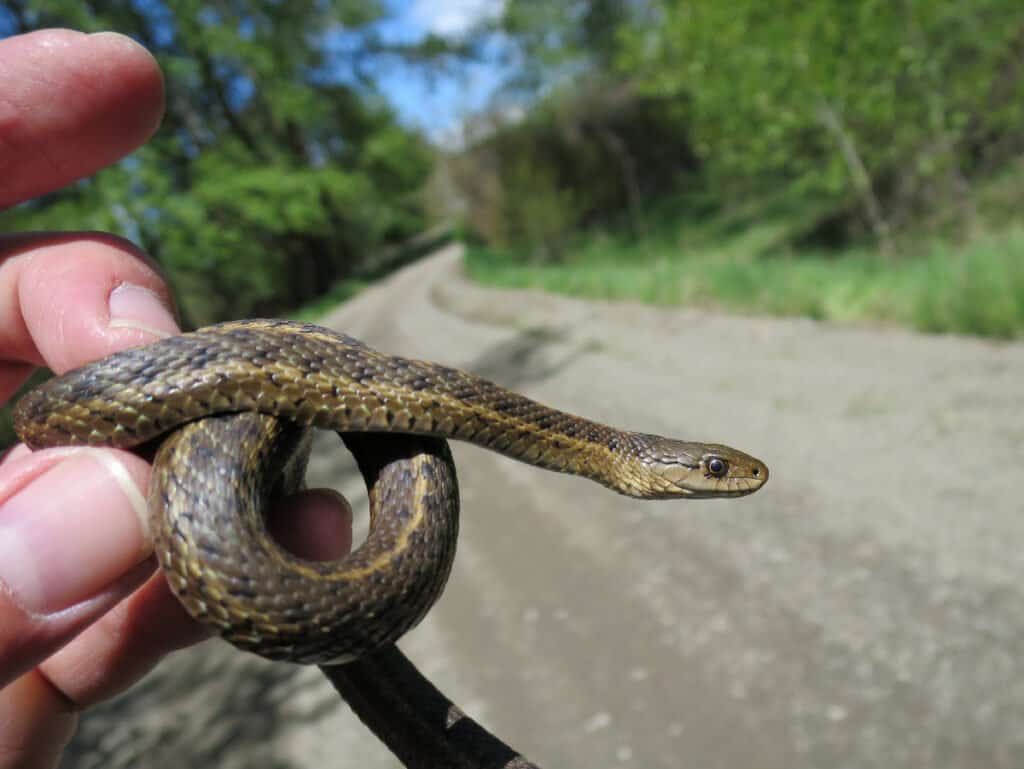
Unlike other garters, the Western terrestrial garter snake tends to constrict their prey.
©Randy Bjorklund/Shutterstock.com
Widespread, the Western terrestrial garter snake lives in various habitats throughout Oregon. They can be found almost anywhere, aside from the highlands of the Cascade mountain range. Some are primarily terrestrial, but others actually enjoy spending time in the water. This preference depends on subspecies and their regions. This species is the only garter snake to show a tendency to constrict prey. They aren’t as adept as typical constrictor snakes and may take much longer to kill their prey. The more aquatic subspecies prey on fish, frogs, and leeches caught in the water. The terrestrial snakes find frogs, toads, lizards, salamanders, slugs, and small mammals. They’re usually gray-brown to black with a darker pattern between their yellow stripes.
Subspecies in Oregon:
- Coast Garter Snake (T. e. terrestris): these snakes live in the southwest corner of Oregon, they’re rarely found further north than the coastal Klamath mountains. They tend to be reddish-brown or olive in body color, with a yellow dorsal stripe and 2 side stripes. They have red flecks along their bodies. This is a terrestrial subspecies.
- Wandering Garter Snake (T. e. vagrans): can be found all over Oregon, especially in the east. They’re abundant east of the Cascade mountains. They usually have dark bodies with a yellow or brownish, uneven stripe. They are adaptive eaters and can enjoy a range of prey, including fish, tadpoles, slugs, snails, worms, mice, frogs, birds, and salamanders.
- Klamath Garter Snake (T. e. biscutatus): this is the largest of the subspecies. They’re semi-aquatic and live mostly in or around water. They have a relatively small range and live mostly in the Southern Klamath area. Klamath garter snakes are usually brown or black with a yellow or brown dorsal stripe.
- Mountain Garter Snake (T. e. elegans): this subspecies lives in Southwestern Oregon, the Klamath-Siskiyou mountains, and the Cascade mountains. They like to live near water or in wet meadows but eat a diet of mostly terrestrial prey. Their coloring is generally brown or black with lighter flecks and a bright yellow or orange dorsal stripe.
Northwestern Garter Snake (Thamnophis ordinoides):
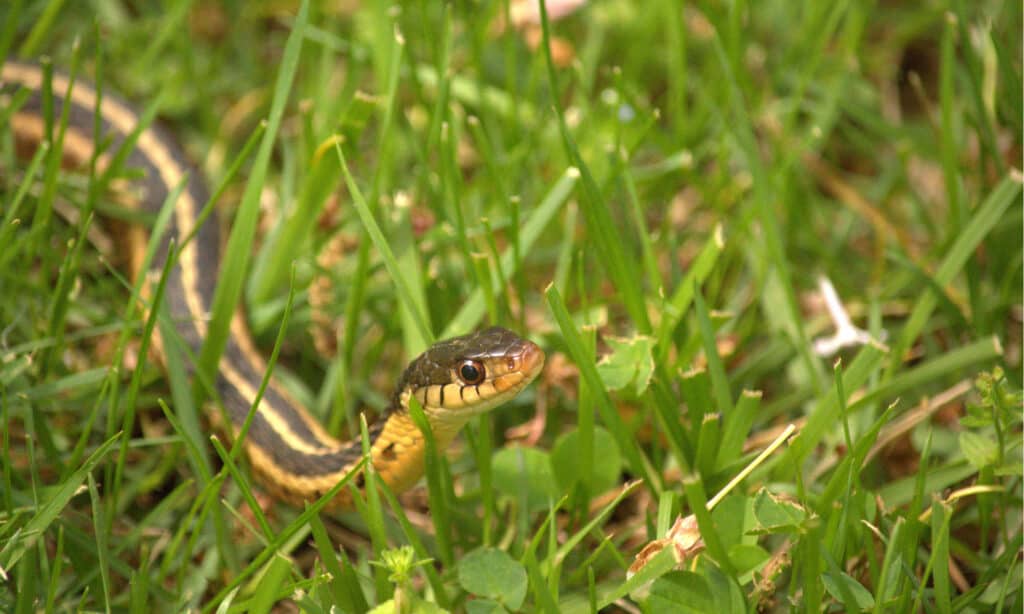
The Northwestern garter snake enjoys grassy areas and weedy backyards.
©Charlotte Payne/Shutterstock.com
West of the Cascade mountain range, you can find the Northwestern garter snake living in coastal and mountain forests. It also enjoys grassy and brush-filled areas and weedy parts of backyards and city parks. These snakes tend to be thinner than other garter snakes and grow to be 2 feet as adults. There are no recognized subspecies, but they present in different morphs or color variations. In fact, of all the Oregon garter snake species, this one shows the most variety in appearance. The dorsal stripe, if it’s there at all, can show up in a rainbow of colors like red, orange, yellow, blue, tan, or white.
The photo featured at the top of this post is © iStock.com/raywhittemore
Discover the "Monster" Snake 5X Bigger than an Anaconda
Every day A-Z Animals sends out some of the most incredible facts in the world from our free newsletter. Want to discover the 10 most beautiful snakes in the world, a "snake island" where you're never more than 3 feet from danger, or a "monster" snake 5X larger than an anaconda? Then sign up right now and you'll start receiving our daily newsletter absolutely free.
Thank you for reading! Have some feedback for us? Contact the AZ Animals editorial team.






